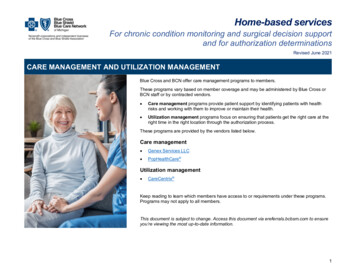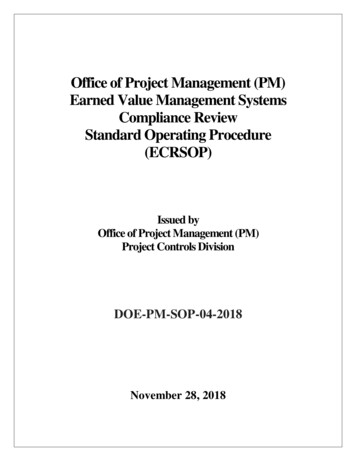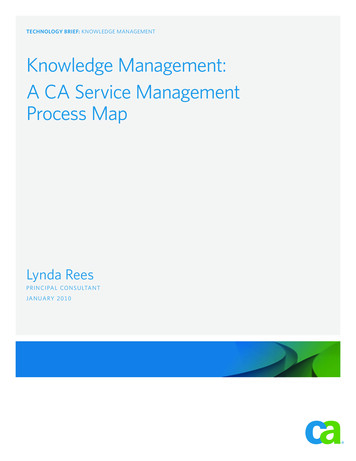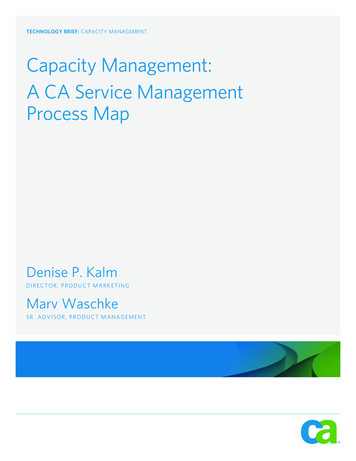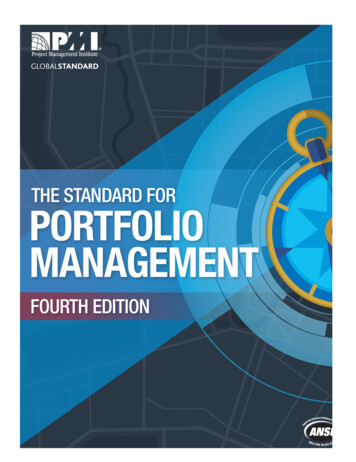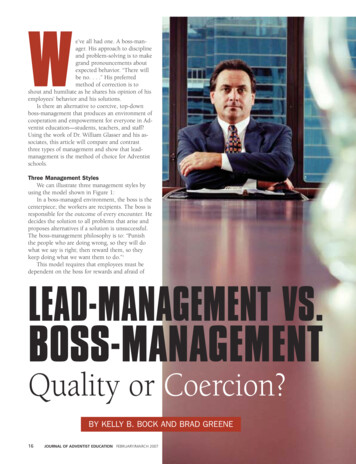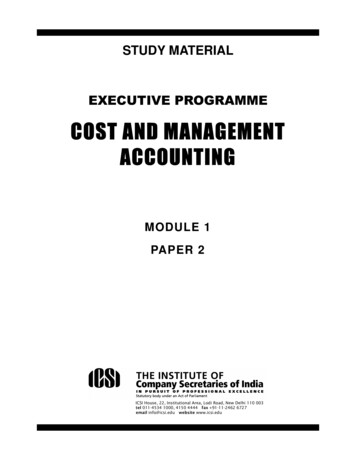
Transcription
STUDY MATERIALEXECUTIVE PROGRAMMECOST AND MANAGEMENTACCOUNTINGMODULE 1PAPER 2ICSI House, 22, Institutional Area, Lodi Road, New Delhi 110 003tel 011-4534 1000, 4150 4444 fax 91-11-2462 6727email info@icsi.edu website www.icsi.edu
THE INSTITUTE OF COMPANY SECRETARIES OF INDIATIMING OF HEADQUARTERSMonday to FridayOffice Timings – 9.00 A.M. to 5.00 P.M.Public Dealing TimingsWithout financial transactions – 9.30 A.M. to 5.00 P.M.With financial transactions – 9.30 A.M. to 4.00 P.M.Phones41504444, fo@icsi.eduLaser Typesetting by Delhi Computer Services, Dwarka, New DelhiPrinted at M. P. Printers/July 2017(ii)
EXECUTIVE PROGRAMMECOST AND MANAGEMENT ACCOUNTINGFinance and accounting have assumed much importance in today’s competitive world of businesswherein corporate organisations have to show the true and fair view of their financial position. Thus,the application of accounting in the business sector has become an indispensable factor. CompanySecretary has to provide the complete and accurate information about the financial operations of thecompany to management for decision making. This emphasises that the books of account are to bemaintained accurately, up-to-date and as per the norms.The subject ‘Cost and Management Accounting’ is very important and useful for optimumutilisation of existing resources. These are branches of accounting and had been developed due tolimitations of financial accounting. It is an indispensable discipline for corporate management, as theinformation collected and presented to management based on cost and management accountingtechniques helps management to solve not only specific problems but also guides them in decisionmaking. Keeping in view the importance of this subject, various topics on Cost and ManagementAccounting have been prescribed in the syllabus of CS Executive Programme with the objective ofacquainting the students with the basic concepts used in cost accounting and managementaccounting having a bearing on managerial decision-making.The entire paper has been discussed in twelve study lessons. In starting four study lessons wehave discussed about the basic of cost accounting, material, labour and overheads costing. Furtherwe have highlighted the concept of activity based costing, cost records, different costing systems.Thereafter study focuses on the marginal costing, standard costing, budgeting & its applications fordecision making in business. At last we have discussed about cost accounting records, cost audit andanalysis & interpretation of financial statements.In this study every efforts has been made to give a comprehensive coverage of all the topicsrelevant to the subject. In all study lessons the requisite theoretical framework for understanding thepractical problems in the subject has been explained and wherever necessary practical illustrationshave been given to facilitate better understanding. At the end of each study lesson a brief about thelesson have been given under the caption ‘Lesson Round Up’ as well a good blend of theoretical andpractical questions have been given under the caption ‘Self Test Questions’ for the practice ofstudents to test their knowledge. In fact, this being a practical paper, students need to have goodtheoretical knowledge and practice to attain the requisite proficiency and confidence.This study material has been published to aid the students in preparing for the Cost andManagement Accounting paper of the CS Executive Programme. It is part of the education kit andtakes the students step by step through each phase of preparation stressing key concepts, pointersand procedures. Company Secretaryship being a professional course, the examination standards areset very high, with emphasis on knowledge of concepts, applications, procedures and case laws, forwhich sole reliance on the contents of this study material may not be enough.Therefore, in order to supplement the information/contents given in the study material, studentsare advised to refer to the Suggested Readings mentioned in the study material, e-bulletin, BusinessDailies and Journals.In the event of any doubt, students may write to the Directorate of Academics and ProfessionalDevelopment in the Institute for clarification at academics@icsi.edu.
(iv)Although due care has been taken in publishing this study material yet the possibility of errors,omissions and/or discrepancies cannot be ruled out. This publication is released with anunderstanding that the Institute shall not be responsible for any errors, omissions and/or discrepanciesor any action taken in that behalf.Should there be any discrepancy, error or omission noted in the study material, the Institute shall beobliged if the same are brought to its notice for issue of corrigendum in the e-bulletin’.The Institute has decided that the examination for this paper under new syllabus from December2014 session in the Optical Mark Recognition (OMR) format, whereby students are required to answermultiple choice question on OMR sheet by darkening the appropriate choice by HB Pencil. One markwill be awarded for each correct answer. Negative marking for wrong answers attempted by thecandidates will be implemented w.e.f. December, 2015 session of examination in the ratio of 1:4, i.e.deduction of one (1) mark for every four (4) wrong answers and total marks obtained by thecandidates in the paper would be rounded up to next whole number. Further, the negative markswould be limited to the extent of marks secured for correct answers so that no candidate shall secureless than zero mark.The specimen OMR sheet is appended at the end of the study material. There is practice testpaper in the study to acquaint students with the pattern of examination. These are for practice purposeonly, not to be sent to the institute.
(v)EXECUTIVE PROGRAMMESYLLABUSFORMODULE 1 - PAPER 2: COST AND MANAGEMENT ACCOUNTING (100 Marks)Level of Knowledge: Working KnowledgeObjective: To acquire knowledge and understanding of the concepts, techniques and practices of costand management accounting and to develop skills for decision making.Detail Contents:1. Introduction to Cost and Management AccountingCost Accounting: Evolution, Meaning, Objectives and ScopeConcepts of Costs , Classifications and Elements of CostCost Centre and Cost UnitMethods and Techniques of CostingCost Accounting StandardsInstallation of a Costing SystemPractical Difficulties in Installing a Costing SystemRole of Cost Accountant in Decision MakingManagement Accounting: Evolution, Meaning, Objectives and ScopeTools and Techniques of Management AccountingRelationship of Cost Accounting, Financial Accounting, Management Accounting andFinancial Management Conflicts in Profit versus Value Maximisation Principle Role of Management Accountant in Decision Making 2. Material Cost Materials Control – Concept and Techniques Procurement Procedures and Documentation: Methods of Purchasing; Procedure ofPurchases, Stores and Issue of Material; Stock Verification Methods of Pricing of Material: FIFO, LIFO, Simple Average, Weighted Average Accounting and Control of Material Losses, Wastage, Scrap, Spoilage and Defectives Inventory Management: Techniques of fixing of minimum, maximum and reorder levels,Economic Order Quantity, ABC Analysis ; Stock Verification and Perpetual Inventory3. Labour Cost Meaning and Classification of Labour CostsAccounting and Control of Labour CostsTime Keeping and Time BookingAttendance and Payroll Procedures, Time Recording, Overtime and Idle TimeLabour turnover and Remedial MeasuresEfficiency Rating Procedures; Remuneration Systems and Incentive Schemes
(vi)4. Direct Expenses and Overheads Direct Expenses: Meaning, Nature, Collection, Classification and Treatment of Direct andIndirect Expenses Overheads: Meaning, Nature, Collection and Classification Functional Analysis: Factory,Administration, Selling, Distribution, Research and Development Behavioural Analysis: Fixed, Variable, Semi variable and Step Cost Allocation,Apportionment, Absorption and Control of Overheads Preparation of Cost Sheet5. Activity Based Costing (ABC) Meaning, Importance, CharacteristicsElements and Steps involvedABC vs. Traditional CostingUses and Limitations6. Cost Records Cost Ledgers – Integrated Accounts and Non-Integrated Accounts Reconciliation of Cost and Financial Accounts7. Costing Systems Unit and Output Costing Job Costing: Job Cost Cards, Collecting Direct Costs, Allocation of Overheads and itsApplications Batch Costing: Features and Applications Contract Costing: Features, Distinction between Job and Contract Costing, ProgressPayments, Retention Money, Escalation Clause, Contract Accounts, Accounting forMaterial, Accounting for Plant Used in a Contract, Contract Profit and Accounting Entries Process Costing: Features, Applications and Types of Process Costing,Process Loss,Abnormal Gains and Losses, Equivalent Units, Inter-Process Profit, Joint Products, ByProducts and Accounting Service Costing: Features and Applications, Unit Costing and Multiple Costing,Application, Identification of Cost Unit and Cost Determination and Control8. Marginal Costing Meaning, Advantages, Limitations and ApplicationsBreakeven AnalysisCost-Volume Profit AnalysisP/V Ratio and its SignificanceMargin of SafetyAbsorption Costing: System of Profit Reporting and Stock ValuationDifference between Marginal Costing and Absorption CostingIncome Measurement under Marginal Costing and Absorption Costing9. Standard Costing Definition, Significance and Applications Various Types of Standards Installation of Standard Costing System-for Material, Labour, and Overhead
(vii) Variance Analysis for Materials, Labour and Overheads and Accounting Treatment ofVariances Benchmarking for Setting of Standards Variance Reporting to Management10. Budget, Budgeting and Budgetary Control Budget Concept, ManualFixed and Flexible BudgetsPreparation and Monitoring of Various Types of BudgetsBudgetary Control System: Advantages, Limitations and InstallationZero Base BudgetingProgramme and Performance Budgeting11. Cost Accounting Records and Cost Audit Nature and Scope of Cost AuditCost Accounting Records and Cost Audit under Companies Act, 2013Purpose, Scope and Advantages of Cost AuditImplementing Authorities of Cost AuditCost Audit Techniques and ProgrammesCost Audit ReportCost Auditor – Appointment, Rights and Responsibilities12. Analysis and Interpretation of Financial Statements Financial Statements: Nature, Attributes, Objectives, Importance, LimitationsRecent Trends in Presenting Financial StatementsFinancial Statements Analysis: Types, Methods, Objectives, LimitationsRatio Analysis: Accounting, Uses, Classification, Advantages, LimitationsCash Flow StatementFund Flow StatementDifference between Cash Flow and Fund Flow StatementManagement Reporting
(viii)LIST OF RECOMMENDED BOOKSMODULE IPAPER 2: COSTAND MANAGEMENT ACCOUNTINGRecommended Readings and References:1.N.S. Zad:Cost & Management Accounting TaxmannPublications Pvt. Ltd.2.Deepak Jain:Cost & Management Accounting TaxmannPublications Pvt. Ltd.3.S.P. Jain & K.L. Narang:Cost and Management Accounting;Kalyani Publishers, 23, Daryaganj,New Delhi-110 002.4.V.K. Saxena& C.D. Vashist:Cost and Management Accounting;Sultan Chand & Sons, 23, DaryaganjNew Delhi -110 002.5.M.N. Arora:Cost and Management Accounting (Theory andProblems); Himalaya Publishing House,Ramdoot, Dr. BhaleraoMarg, Kelewadi,Girgaon, Mumbai-400 004.6.S.N. Maheshwari:Cost and Management Accounting;Sultan Chand & Sons, 23, DaryaganjNew Delhi -110 002.7.I.M. Pandey:Management Accounting;Vikas Publishing House (P) Ltd.A-22, Sector 4, Noida – 201 3018.Ravi M. Kishore:Advanced Management Accounting;Taxmann’s, Taxmann Publication (P) Ltd.59/32, New Rohtak Road, New Delhi – 110 005.9.M.Y. Khan & P.K. Jain:Theory and Problems of Management and CostAccounting; McGraw-Hill Education (India) Ltd.B-4, Sector 63, Gautam Budh Nagar,Noida – 201 301.10.JawaharLal:Cost Accounting; McGraw-Hill Education (India) Ltd.B-4, Sector 63, GautamBudh Nagar,Noida – 201 301.11.C.T. Horngren:Cost and Management Accounting - A ManagerialEmphasis; Pearson Education Asia,482, F.I.E. Patparganj, Delhi-110 092.
(ix)12.B.M. Lall Nigam & I.C. Jain:Cost Accounting Principles and Practice;Prentice Hall of India, M-97, Connaught Circus,New Delhi-110 001.13.Drury Colin:Management and Cost Accounting; InternationalThomson Business Press, London.14.K.S. Thakur:Cost Accounting – Theory & Practice;Excel Books, A-45, Naraina, Phase-I,New Delhi-110028.15B.M. Lall Nigam and I.C. JainCost Accounting Principles and Practice - PHILearning Private Limited16Ashish K. BhattacharyyaPrinciples and Practice of Cost Accounting- PHILearning Private Limited
(x)ARRANGEMENT OF STUDY LESSONSPAPER 2: COSTAND MANAGEMENT ACCOUNTING (100 Marks)Lesson No.Subject1.Introduction to Cost and Management Accounting2.Material Cost3.Labour Cost4.Direct Expenses and Overheads5.Activity Based Costing (ABC)6.Cost Records7.Costing Systems8.Marginal Costing9.Standard Costing10.Budget, Budgeting and Budgetary Control11.Cost Accounting Records and Cost Audit12.Analysis and Interpretation of Financial StatementsPRACTICE TEST PAPER
EXECUTIVE PROGRAMMECOST AND MANAGEMENT ACCOUNTINGCONTENTSLESSON 1INTRODUCTION TO COST AND MANAGEMENT ACCOUNTINGPageLearning Objectives 1Concepts of Cost.2Evaluation of Cost Accounting 3Costing, Cost Accounting and Cost Accountancy.3Objectives of Cost Accounting.4Importance of Cost Accounting.5Scope of Cost Accounting 6Classifications of Costs.7Cost Centre and Cost Unit.15Methods of Costing.16Techniques of Costing.18Cost Accounting Standards 19Installation of a Costing System.22Practical Difficulties in Installing a Costing System.24Role of Cost Accounting in decision making 25Management Accounting.26Objective of Management Accounting.28Nature of Management Accounting.29Scope of Management Accounting.29Tools and Techniques of Management Accounting.30Difference between Financial Accounting and Cost Accounting.32Difference between Financial Accounting and Management Accounting.33Difference between Cost Accounting and Management Accounting.34Limitations of Management Accounting.35Conflicts in Profit versus Value Maximization Principle 36Role of Management Accountant in Decision Making.37LESSON ROUND-UP.38SELF-TEST QUESTIONS.38
(xii)LESSON 2MATERIAL COSTPageLearning Objectives 41Inventory Control.42Objectives of Inventory Control.42Techniques of Inventory Control.42Procurement Procedure & Documentation 61Methods of Purchasing.62Purchase Procedure.63Pricing of Stores Receipts.65Store-keeping.68Functions of Store-keeping.69Classification and Codification of Materials.69Issue of Materials.70Material (Stores) Requisition Note.70Bill of Materials.70Stock Verification 71Method of Pricing of Material Issues.72Pricing of Material Returns.88Material Transfer Note.89Accounting of Material Losses.89Control of Material Losses.92Inventory Management 96LESSON ROUND-UP.96SELF-TEST QUESTIONS.97Learning Objectives 103Labour Cost 104Classification of Labour Cost 104Accounting and Control of Labour Cost 105Time Recording 106Time Keeping 106Time Booking 107Attendance and Payroll Procedure 108LESSON 3LABOUR COST
(xiii)PageOvertime.109Idle Time.110Labour Turnover.112Labour Remuneration System.117Basic Methods of Remuneration.118Incentive Schemes.121Classification of Incentive Schemes.122Indirect Monetary Incentive Schemes.128Other Non-monetary Incentive Schemes.130Miscellaneous Topics.142LESSON ROUND-UP.144SELF-TEST QUESTIONS.144Learning Objectives 147Direct Expenses.148Indirect Expenses.149Overheads.150Collection of Overheads.150Classification of Overheads.151Procedure for Accounting and Control of Overheads 158Allocation of Overheads.159Apportionment of Overheads.160Absorption of Overheads.166Methods of Absorbing Production Overheads.167Over or Under Absorption of Overheads.176Treatment of Factory Overheads.177Treatment of Administrative Overheads.178Treatment of Selling and Distribution Overheads.180Control of Overheads.183Preparation of Cost Sheet 185LESSON ROUND-UP.186SELF-TEST QUESTIONS.187LESSON 4DIRECT EXPENSES AND OVERHEADS
(xiv)LESSON 5ACTIVITY BASED COSTINGPageLearning Objectives 189Introduction of Activity Based Costing 190Meaning of Activity Based Costing 190Basics of Activity Based Costing 191Evolution of Activity Based Costing 191Distinction between traditional absorption costing and Activity Based Costing 192Objectives of Activity Based Costing 192Terminology of Activity Based Costing 193Stages in Developing Activity Based Costing 193Different Types of Activities 195Importance of Activity Based Costing 195Uses of Activity Based Costing 196Limitations of Activity Based Costing 197LESSON ROUND-UP.203SELF-TEST QUESTIONS.203 207Introduction 208Non-Integrated Accounting System 208— Principal Ledgers 208— Control Accounts 209— Entries to record transaction 209Advantages of non-integrated accounting 211Limitations of non-integrated accounting 212Integrated Accounting System 212Benefits of Integrated Accounting System 212Pre-requisites for an Integrated Accounting System 212Essential features of Integral Accounting 213Need for Reconciliation 218Causes of Difference 219LESSON 6COST RECORDSLearning ObjectivesCost LedgerReconciliation of Cost and Financial AccountsI.Items Shown only in Financial Accounts 219II.Items Included in Cost Accounts Only 220III.Over or Under Absorption of Overheads 220
(xv)PageIV. Adoption of Different Basis of Valuation of Stock 220V. 220 221Preparation of Reconciliation Statement or Memorandum Reconciliation Account 221LESSON ROUND-UP.230SELF-TEST QUESTIONS.230Learning Objectives 237Single/Output/Unit Costing 238Cost Sheet 238Production Account 240Job Costing 246— Meaning 246— Features 246— Basic Principles & Special Terms 247— Applications 249— Advantages and Limitations 249 252— Features 252— Difference between Job Costing and Batch Costing 252— Applications 253 254— Distinction between job and contract costing 254— Specific aspects and recording of transactions of contract costing 254— Profits on Incomplete Contract (Based on AS-7-Revised 2002) 262 266— General Principles of Process Costing 266— Features of Process Costing 266— Applications of Process Costing 267— Comparison between Job Costing and Process Costing 267— Advantages and Limitations of Process Costing 268— Accounting for Element of Cost 269— Cost of Process 270— Process Losses 271— Inter Process Profit 278— Valuation of Work in Progress (Equivalent Production) 280— By-Products and Joint Products 290Different Methods of Charging DepreciationVI. Abnormal Gains and LossesLESSON 7COSTING SYSTEMBatch CostingContract CostingProcess Costing
(xvi)Page— Accounting for By-Products 290— Accounting for Joint Products 291— Co-Products 293 295— Features of Service Costing 296— Applications of Service Costing 296— Unit Costing and Multiple Costing 296— Cost Unit 297— Transport Costing 297— Bailer House Costing 300— Canteen Costing 301— Hospital Costing 302LESSON ROUND-UP.313SELF-TEST QUESTIONS.314Learning Objectives 321Marginal Costing.322Features of Marginal Costing 322Advantages of Marginal Costing 322Limitations of Marginal Costing 323Break-even Analysis/Cost-Volume-Profit Analysis.324Objectives of Cost-Volume-Profit Analysis.325Advantages of Break-even Analysis.326Limitations of Break-even Analysis.326Uses of Cost Volume Profit Analysis 327Contribution.327Marginal Cost Equation 328Profit-Volume Ratio.328Margin of Safety.329Methods for Determining Break-even Points.330Break-even Chart 337Profit-Volume Chart 338Applications of Marginal Costing.339Composite Break-Even Point.349Absorption Costing 358System of Profit Reporting 358Difference between Absorption Costing and Marginal Costing.359Service CostingLESSON 8MARGINAL COSTING
(xvii)PageIncome Measurement under Marginal and Absorption Costing.360Pricing Decisions (Discriminating Price and Differential Selling).364LESSON ROUND-UP.371SELF-TEST QUESTIONS.373Learning Objectives 377Standard Costing.378Definition and Meaning of Standard Costing.378Significance/Advantages of Standard Costing.379Applications Standard Costing 380Various Types of Standards.381Standard Costing System 382Installation of a Standard Costing System 382Functions of a Standard Costing System 382Features of a Standard Costing System 383Standard Cost for Material, Labour and Overhead 383Direct Materials Standards.383Standard Cost for Direct Labour.384Standard Overhead Rates.384Standard Administration Costs.385Standard Costs for Selling and Distribution.385Variance analysis.385Material Cost Variance.389Labour Cost Variance.398Overhead Cost Variances.405Variable Overhead Variance 406Fixed Overhead Variance 408Accounting Treatment of Variance 413Bench Marking for setting of a standards 414Reporting of Variances to Management.415LESSON ROUND-UP.415SELF-TEST QUESTIONS.417Learning Objectives 419Budget.420Budgeting 420LESSON 9STANDARD COSTING AND VARIANCE ANALYSISLESSON 10BUDGET, BUDGETING AND BUDGETARY CONTROL
(xviii)PageBudgetary Control.420Forecast and Budget.421Objectives of Budgetary Control.422Advantages of Budgetary Control.422Limitations of Budgetary Control.423Preliminaries for the Adoption of a System of Budgetary Control.424Installation of Budgetary Control System.424Preparation and Monitoring of various types of Budgets 429Zero Base Budgeting.443Difference between Traditional Budgeting and Zero-base Budgeting 444Advantages of Zero Base Budgeting 444Programme Budgeting 445Performance Budgeting.445LESSON ROUND-UP.446SELF-TEST QUESTIONS.447Learning Objectives 449Cost Audit 450Provisions of Companies Act, 2013 pertaining to Cost Accounting Records 450Provisions of Companies Act, 2013 pertaining to Cost Audit 450Purpose of Cost Audit 452Scope of Cost Audit 453Advantages of Cost Audit 454Appointment and Remuneration of Cost Auditor 455Rights and Responsibilities of Cost Auditor 456Cost Audit Techniques 457Cost Audit Programme 458Cost Audit Report 459LESSON ROUND-UP 460SELF-TEST QUESTIONS 460LESSON 11COST ACCOUNTING RECORDS AND COST AUDITLESSON 12ANALYSIS AND INTERPRETATION OF FINANCIAL STATEMENTSLearning Objectives 461Financial Statements.462Nature of Financial Statements.462Attributes of Financial Statements.463
(xix)PageObjectives of Financial Statements.465Importance of Financial Statements.466Limitations of Financial Statements.467Recent Trends in Presenting Financial Statements.468Analysis of Financial Statements.469Objectives of Financial Statement Analysis.470Limitations of Financial Statement Analysis.470Types of Financial Statement Analysis.471Methods of Analysing Financial Statements.472Ratio Analysis 479Accounting Ratios.479Uses of Ratio Aalysis 480Classification of Ratios.481Advantages of Ratio Analysis.496Limitations of Ratio Analysis.496Cash Flow Statement 514Classification of Cash Flows.515Special Items.516Preparation of a Cash Flow Statement.518Reporting of Cash Flows from Operating Activities.518Format of Cash Flow Statement.523Usefulness of Cash Flow Statement.525Fund Flow Statement 537Meaning and Definition of Fund Flow Statement 538Steps for Preparation of Fund Flow Statement 539Difference between Cash Flow and Fund Flow 551Management Reporting 551Role of Management Information System 552LESSON ROUND-UP 553SELF-TEST QUESTIONS 553.561Practice Test PaperPractice Test PaperSpecimen OMR Answer Sheet
Lesson 1Introduction to Cost andManagement AccountingLESSON OUTLINELEARNING OBJECTIVES Concept of Cost Evolution of Cost Accounting Costing, CostAccountancy Objectives, Importance and Scope of costaccounting Classifications and Elements of Cost Cost Centre and Cost Unit Methods and Techniques of Costing Cost Accounting Standards Installation of a Costing System Practical Difficulties in Installing a CostingSystemAccountingandCostAccounting information is important for everybusiness which will serve the needs of variety ofinterested parties. To satisfy the needs of allinterested parties a sound accounting system is verynecessary. Accounting may be divided into threeparts i. financial accounting ii. cost accounting iii.management accounting.Financial accounting is mostly concerned to recordthe business transactions in books of accounts sothat final accounts can be prepared. Role of Cost Accountant in DecisionMaking Management Accounting and its Evolution,Meaning, Objectives, Nature and Scope Tools and Techniques of ManagementAccounting Relationship of Cost Accounting, FinancialAccounting, Management Accounting andFinancial Management Limitations of Management Accounting ConflictsinProfitMaximisation Principleversus Role of ManagementDecision MakingAccountant Lesson Round Up Self-Test QuestionsValueinCost accounting developed to help the internalmanagement in decision making. The informationprovided by cost accounting acts as a managerialtool so that business can utilise the availableresources at optimum level.Management accounting is an extension ofmanagement aspects of cost accounting. It providesthe information to management so that planning,organizing, directing and controlling of businessoperations can be done in an orderly manner.Therefore the objective of the lesson is to enable thestudent to understand the meaning and purpose ofcost and management accounting. What are thevarious methods and technique of cost accounting sothat various information can be provided tomanagement for decision making.After going through this lesson the students will beable to1. Understand the nature, scope and utility of costaccounting, management accounting and costaccounting standards.2. Understand how cost accounting arises out of theneed to make business decisions.3. Difference between cost accounting, managementaccounting and financial accounting.4. To familiarize with costing terminology.Management Accounting is concerned with the information which is useful to Management.
2EP-CMACONCEPTS OF COSTCost is the amount of resource given up in exchange for some goods or services. The resources given upare money or money’s equivalent expressed in monetary units.The Chartered Institute of Management Accountants, London defines cost as “the amount ofexpenditure (actual or notional) incurred on, or attributable to a specified thing or activity”.This activity of a firm may be the manufacture of a product or the rendering of a service which involvesexpenditure under various heads, e.g., materials, labour, other expenses, etc. A manufacturing organisationis interested in ascertaining the cost per unit of the product manufactured while an organisation renderingservice, e.g., transport undertaking, canteen, electricity company, municipality, etc., is interested inascertaining the costs of the service it renders. In its simplest form, the cost per unit is arrived at by dividingthe total expenditure incurred by the total units produced or the quantum of service rendered. But thismethod is applicable if the manufacturer produces only one product. If the manufacturer produces more thanone product, it becomes imperative to split up the total expenditure between the various products so that thecost of each product can be ascertained separately. Even if only one product is manufactured, it may benecessary to analyse the cost per unit of each item of expenditure that goes to make up the total cost. Theproblem becomes more complicated where a multiplicity of products is produced and it is necessary toanalyse the cost per unit of each product into various items of expenditures that make up the total cost.For a consumer cost means price. For management cost means 'expenditure incurred' for producing aparticular product or rendering a particular service. The process of ascertaining the cost is known ascosting. It consists of principles and rules governing the procedure of finding out the costs of goods/services. It aims at ascertaining the total cost and also per unit cost. For instance, in transport companies thetotal cost for the period is ascertained and used to find out the cost per passenger/mile. i.e. the cost ofcarrying one passenger for one mile. It provides for analysis of expenditure in such a way that themanagement gets complete idea about even the smallest item of cost.It is necessary to specify the exact meaning of “cost”. When the term is used specifically, it is modified withsuch terms as prime cost, fixed cost, sunk cost, etc. Each description implies a certain characteristic which ishelpful in analysing the cost. It helps cost accounting in achieving its three basic objectives namely-costascertainment, cost control and cost presentation.A cost must always be studied in relation to its purpose and conditions. Different costs may be ascertainedfor different purposes and under different conditions. Work-in-progress is valued at factory cost, while stockof finished goods may be valued at cost of production. Even if the purpose of the study of cost is the same,different conditions may lead to variation in cost. The cost per unit of a product is sure to vary with anincrease in the volume of output since the amount of fixed expenses to be borne by each unit of outputdecreases.It is also important to note here that there is no such thing as an exact cost or true cost because no figure ofcost is true in all circumstances and for all purposes. Most of the costing information is based on estimates;for example, the amount of overheads is generally estimated in advance; it is distributed over cost units,again on an estimated basis using different methods. Man
This emphasises that the books of account are to be . Management Accounting paper of the CS Executive Programme. It is part of the education kit and takes the students step by step through each phase of preparation stressing key concepts, pointers and procedures. Company Secretaryship b


